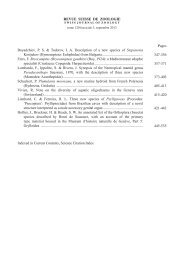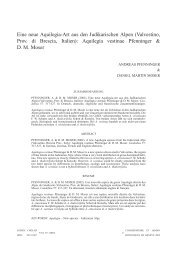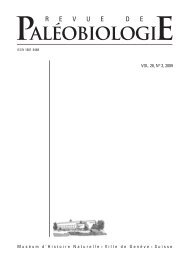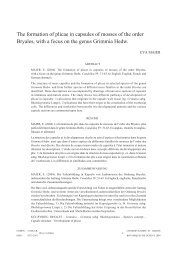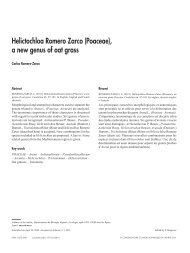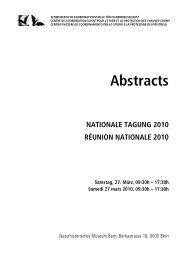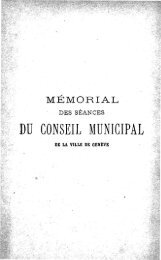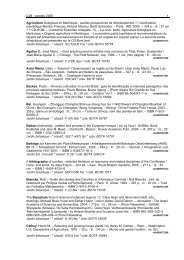Jean-Jacques and his main steps in botany - Ville de Genève
Jean-Jacques and his main steps in botany - Ville de Genève
Jean-Jacques and his main steps in botany - Ville de Genève
You also want an ePaper? Increase the reach of your titles
YUMPU automatically turns print PDFs into web optimized ePapers that Google loves.
<strong>Jean</strong>-<strong>Jacques</strong> <strong>and</strong> <strong>his</strong> <strong>ma<strong>in</strong></strong> <strong>steps</strong> <strong>in</strong> <strong>botany</strong><br />
RoUssEaU’s aNTi-<br />
mEdiCal HERbalism<br />
1712-1739<br />
i n<br />
March 1728, Rousseau fled Geneva.<br />
In Annecy, he met Françoise-Louise<br />
<strong>de</strong> la Tour, baronne <strong>de</strong> Warens (1699-<br />
1762), an aristocrat from canton of Vaud,<br />
whom he called “Maman”; like many<br />
women of her class, M me <strong>de</strong> Warens ma<strong>de</strong><br />
herbal medic<strong>in</strong>es at home, but unusually,<br />
she also produced them for the commercial<br />
“ Two or three times the contentment I<br />
saw <strong>in</strong> Anet’s eyes upon com<strong>in</strong>g back<br />
bur<strong>de</strong>ned with new plants brought to me to the po<strong>in</strong>t of<br />
go<strong>in</strong>g herboriz<strong>in</strong>g with him. I am almost sure that if<br />
I had done so a s<strong>in</strong>gle time it would have won me over,<br />
<strong>and</strong> perhaps I would be a great botanist today:<br />
for I know no study <strong>in</strong> the world that mixes better with<br />
my natural tastes than that of plants, <strong>and</strong> the life that<br />
I have been lead<strong>in</strong>g for the past ten years <strong>in</strong> the country<br />
is hardly anyth<strong>in</strong>g but a cont<strong>in</strong>uous herborization....<br />
s<strong>in</strong>ce I did not have any i<strong>de</strong>a of <strong>botany</strong> at that time,<br />
I had acquired a sort of disda<strong>in</strong> <strong>and</strong> even disgust for it;<br />
I looked as it as a sort of Apothecary’s study.”<br />
(Christopher Kelly (trans.), “The Confessions”<br />
<strong>in</strong> The collected writ<strong>in</strong>gs of Rousseau, vol. 5<br />
[Hanover, NH: University Press of New Engl<strong>and</strong>, 1995], p. 151)<br />
market, assisted by her valet, Clau<strong>de</strong> Anet<br />
(d. 1734), who knew plants <strong>and</strong> their uses.<br />
Rousseau later claimed that he believed<br />
<strong>botany</strong> suited <strong>his</strong> natural <strong>in</strong>cl<strong>in</strong>ations from<br />
a young age even if he did not act upon <strong>his</strong><br />
<strong>in</strong>cl<strong>in</strong>ation until middle age. He justified<br />
t<strong>his</strong> <strong>de</strong>lay by cit<strong>in</strong>g <strong>his</strong> distaste for the<br />
pharmaceutical use of plants.<br />
Private conversation between<br />
J. J. Rousseau with M me <strong>de</strong> Warens<br />
draw<strong>in</strong>g by m. leloir engraved by l. Ruet<br />
© akg-images / <strong>de</strong> agost<strong>in</strong>i Picture library<br />
1712<br />
Rousseau is boRn on 28 June.<br />
1717<br />
DiscoveRy of plant sexuality by the fRench<br />
botanist, sebastien vaillant (1669-1722).<br />
1727<br />
beg<strong>in</strong>n<strong>in</strong>g of woRk on plant physiology: the<br />
english physiologist, stephen hales (1677-<br />
1761), highlights plant tRanspiRation.<br />
1736<br />
<strong>Jean</strong>-<strong>Jacques</strong> Rousseau leav<strong>in</strong>g Geneva <strong>in</strong> 1728<br />
V<strong>in</strong>tage poster by J. Courvoisier, 1912<br />
© bGE - Geneva library, Geneva iconographic Collection<br />
<strong>in</strong> <strong>his</strong> SyStema naturae the sweDish botanist<br />
caRolus l<strong>in</strong>naeus (1707-1778) pResents <strong>his</strong> sexual<br />
system of plant classification, which is baseD on<br />
the numbeR of stamens anD the position of pistils.<br />
(Kenneth Yung & alex<strong>and</strong>ra Cook, trans.)
<strong>Jean</strong>-<strong>Jacques</strong> <strong>and</strong> <strong>his</strong> <strong>ma<strong>in</strong></strong> <strong>steps</strong> <strong>in</strong> <strong>botany</strong><br />
RoUssEaU iN THE<br />
CHEmiCal laboRaToRY<br />
1740-1750<br />
A diversion dur<strong>in</strong>g one of Rouelle’s chemistry lectures at the Jard<strong>in</strong> du Roi [Paris] From <strong>de</strong> l. Figuier, Vies <strong>de</strong>s savants illustres: savants du XVIII e siècle, Hachette, Paris, 1874 © iam /akg-images<br />
i n<br />
the 1740’s Rousseau studied chemistry<br />
<strong>in</strong> Paris with <strong>his</strong> patron, Dup<strong>in</strong> <strong>de</strong><br />
Francueil. Francueil set up a laboratory,<br />
a costly <strong>in</strong>dividual un<strong>de</strong>rtak<strong>in</strong>g before<br />
the <strong>in</strong>stitutionalisation of science. Rous-<br />
seau wrote a long treatise on chemistry,<br />
Institutions chimiques, which was discov-<br />
ered <strong>in</strong> 1882 <strong>in</strong> Trélex (canton of Vaud).<br />
These studies <strong>in</strong>fluenced <strong>his</strong> turn to bot-<br />
any: he characterized the fields as the<br />
botanist’s “only laboratory”, but he rejected<br />
chemical analysis <strong>and</strong> the pharmacist’s<br />
mortar <strong>and</strong> pestle, preferr<strong>in</strong>g to preserve<br />
the plant itself.<br />
“I became attached to Chemistry. Along with<br />
M. <strong>de</strong> Francueil I took several courses with M. Rouelle,<br />
<strong>and</strong> for good or ill we began to scribble on paper about that science<br />
whose elements we barely possessed. In 1747 we went to pass the<br />
autumn <strong>in</strong> [Toura<strong>in</strong>e] at the Château of Chenonceaux, the royal<br />
house on the Cher, built by Henri II for Diane <strong>de</strong> Poitiers....<br />
I composed other little works there... <strong>and</strong> all that was done without<br />
discont<strong>in</strong>u<strong>in</strong>g my work on Chemistry....”<br />
Christopher Kelly (trans.), “The Confessions” <strong>in</strong> The collected writ<strong>in</strong>gs of Rousseau, vol. 5<br />
[Hanover, NH: University Press of New Engl<strong>and</strong>, 1995], p. 287<br />
“M. <strong>de</strong> Francueil was study<strong>in</strong>g natural <strong>his</strong>tory <strong>and</strong> chemistry at that<br />
time <strong>and</strong> was mak<strong>in</strong>g a [natural <strong>his</strong>tory] collection. I believe that he<br />
aspired to the Aca<strong>de</strong>my of Sciences: for that purpose he wanted to write<br />
a book, <strong>and</strong> he judged that I could be useful to him <strong>in</strong> t<strong>his</strong> labor.”<br />
Christopher Kelly (trans.), “The Confessions” <strong>in</strong> The collected writ<strong>in</strong>gs of Rousseau, vol. 5<br />
[Hanover, NH: University Press of New Engl<strong>and</strong>, 1995], p. 286
<strong>Jean</strong>-<strong>Jacques</strong> <strong>and</strong> <strong>his</strong> <strong>ma<strong>in</strong></strong> <strong>steps</strong> <strong>in</strong> <strong>botany</strong><br />
HERboRisaTioNs:<br />
sCiENCE aNd soCiabiliTY<br />
1764-1778<br />
i n<br />
the eighteenth century the “herborisation”,<br />
or botanical expedition, formed an essential<br />
part of the botanist’s tra<strong>in</strong><strong>in</strong>g, <strong>and</strong> provi<strong>de</strong>d<br />
the specimens for the herbarium, a collection<br />
of dried plants preserved for future reference<br />
<strong>and</strong> pedagogical purposes. From 1764 to 1778<br />
Rousseau ma<strong>de</strong> many botanical expeditions<br />
<strong>in</strong> Switzerl<strong>and</strong>, <strong>in</strong> Engl<strong>and</strong>, <strong>in</strong> the Dauph<strong>in</strong>é,<br />
<strong>and</strong> the environs of Paris; these were usually <strong>in</strong><br />
the company of other botanists or stu<strong>de</strong>nts of<br />
<strong>botany</strong>. He recounts these expeditions <strong>in</strong> <strong>his</strong><br />
correspon<strong>de</strong>nce <strong>and</strong> The Reveries of the Solitary<br />
Walker. These expeditions were scientific as well<br />
as sociable, with the goal of collect<strong>in</strong>g complete<br />
specimens, especially of rare species.<br />
J. J. Rousseau botaniz<strong>in</strong>g <strong>in</strong> the vic<strong>in</strong>ity of Montreuil<br />
oil on canvas by C. Fouqueray<br />
© ile-<strong>de</strong>-France Region - General <strong>in</strong>ventory / J. b. Vialles<br />
© document Hôtel-<strong>de</strong>-<strong>Ville</strong> <strong>de</strong> montreuil<br />
“It was... <strong>in</strong> 1764 that Mr. du Peyrou, Colonel Pury, Rousseau <strong>and</strong> myself were all together<br />
<strong>in</strong> the val <strong>de</strong> Travers. We planned to collect plants from all over the Jura, to study the sexual<br />
system of L<strong>in</strong>næus, to draw on the general pr<strong>in</strong>ciples of the science [of <strong>botany</strong>], to study the stamens <strong>and</strong><br />
pistils with the help of a magnify<strong>in</strong>g glass, to study <strong>in</strong> each plant the traits assigned to each of the twenty-<br />
four classes of the <strong>in</strong>genious nomenclature of that great naturalist. Rousseau recommen<strong>de</strong>d that we each<br />
take a copy of L<strong>in</strong>næus’s Systema naturæ.”<br />
1751<br />
l<strong>in</strong>naeus pResents elements of a pRelim<strong>in</strong>aRy<br />
natuRal methoD foR the classification of<br />
plants <strong>in</strong> <strong>his</strong> PhiloSoPhia botanica.<br />
1753<br />
<strong>in</strong> <strong>his</strong> SPecieS Plantarum l<strong>in</strong>naeus <strong>in</strong>vents<br />
a b<strong>in</strong>omial nomenclatuRe <strong>in</strong> lat<strong>in</strong> (genus<br />
name followeD by the species name) foR the<br />
nam<strong>in</strong>g all plants.<br />
1762<br />
the english botanist, william huDson (1730-<br />
1793), aDopts l<strong>in</strong>naean nomenclatuRe foR <strong>his</strong><br />
Flora anglica, a woRk on english plants.<br />
1763-1764<br />
the fRench botanist, michel aDanson (1727-<br />
1806), <strong>in</strong>tRoDuces an oRig<strong>in</strong>al methoD of<br />
natuRal plant classification, which is baseD<br />
on 65 chaRacteRs <strong>in</strong> <strong>his</strong> Famille <strong>de</strong>S PlanteS.<br />
1768<br />
the swiss (beRnese) botanist, albRecht von<br />
halleR (1708-1777), publishes <strong>his</strong> hiStoria<br />
StirPium <strong>in</strong>digenarum helvetiae, the fiRst floRa<br />
of switzeRlanD, but Does not use l<strong>in</strong>naean<br />
nomenclatuRe.<br />
1774<br />
the fRench botanist, anto<strong>in</strong>e-lauRent De<br />
Jussieu (1748-1836), publishes <strong>his</strong> exPoSition d’un<br />
nouvel ordre <strong>de</strong>S PlanteS, adoPté danS leS démonStra-<br />
tionS du jard<strong>in</strong> royal, the basis foR the cuRRent<br />
classification of the moRe impoRtant plants,<br />
<strong>in</strong>cluD<strong>in</strong>g the maJoRity of the “natuRal” plant<br />
family names that aRe cuRRently RecogniseD.<br />
1778<br />
Rousseau Dies on 2 July at the age of 66.<br />
(Kenneth Yung & alex<strong>and</strong>ra Cook, trans.)<br />
J. J. Rousseau return<strong>in</strong>g<br />
from botanis<strong>in</strong>g <strong>in</strong><br />
June 1778<br />
draw<strong>in</strong>g by N. monsiau<br />
engraved by l.-m. Halbou, 1797<br />
© bGE - Geneva library,<br />
Geneva iconographic Collection<br />
François-louis d’Escherny, Mélanges <strong>de</strong> littérature, d’<strong>his</strong>toire, <strong>de</strong> morale et <strong>de</strong> philosophie, vol. 3<br />
[Paris: bossange, 1811], p. 41<br />
(orange Translations & R<strong>in</strong>ske Kuiper, trans.)
<strong>Jean</strong>-<strong>Jacques</strong> <strong>and</strong> <strong>his</strong> <strong>ma<strong>in</strong></strong> <strong>steps</strong> <strong>in</strong> <strong>botany</strong><br />
sCiENCE<br />
aNd aEsTHETiCs:<br />
RoUssEaU’s HERbaRia<br />
H erbaria<br />
are dried plant collections,<br />
which are used for teach<strong>in</strong>g,<br />
research, <strong>and</strong> record<strong>in</strong>g biodiversity.<br />
Rousseau ma<strong>de</strong> herbaria for <strong>his</strong> friends <strong>in</strong><br />
or<strong>de</strong>r to teach them <strong>botany</strong> <strong>and</strong> awaken<br />
their <strong>in</strong>terest <strong>in</strong> nature. How he learned<br />
t<strong>his</strong> art is not exactly known, yet Rousseau<br />
was an artisan at heart, acquir<strong>in</strong>g many<br />
“All of a<br />
sud<strong>de</strong>n at the age<br />
of sixty-five plus, <strong>de</strong>prived of<br />
the little memory I used to<br />
have <strong>and</strong> of my re<strong>ma<strong>in</strong></strong><strong>in</strong>g<br />
strength to w<strong>and</strong>er around the<br />
countrysi<strong>de</strong>, without a gui<strong>de</strong>,<br />
without books, without a<br />
gar<strong>de</strong>n, without a herbarium,<br />
here I am caught up aga<strong>in</strong> <strong>in</strong><br />
t<strong>his</strong> folly, but with still more<br />
ardor than I had <strong>in</strong> giv<strong>in</strong>g<br />
myself up to it the first time.<br />
Now I am seriously preoccu-<br />
pied with the pru<strong>de</strong>nt project<br />
of learn<strong>in</strong>g [Johan Andreas]<br />
Murray’s whole Regnum<br />
vegetabile by heart <strong>and</strong> of<br />
becom<strong>in</strong>g acqua<strong>in</strong>ted with all<br />
the known plants on earth.<br />
Unable to buy any <strong>botany</strong><br />
books aga<strong>in</strong>, I set myself the<br />
task of copy<strong>in</strong>g those lent<br />
to me <strong>and</strong> resolved to make<br />
another herbarium richer<br />
than the first, while wait<strong>in</strong>g<br />
to put all the plants of the<br />
seas <strong>and</strong> the Alps <strong>and</strong> all the<br />
trees of the Indies <strong>in</strong> it....”<br />
Charles E. butterworth (trans.)<br />
“The Reveries of the solitary walker, seventh<br />
walk” <strong>in</strong> The collected writ<strong>in</strong>gs of Rousseau, vol. 8<br />
[Hanover, NH: University Press of New Engl<strong>and</strong>, 2000],<br />
pp. 57-58<br />
Amourettes tremblantes<br />
[Quak<strong>in</strong>g grass, Briza media l.]<br />
From the «Small herbarium for<br />
Ma<strong>de</strong>moiselle Julie Boy <strong>de</strong> la Tour»<br />
© Zurich Central library<br />
skills dur<strong>in</strong>g <strong>his</strong> life-engrav<strong>in</strong>g, music-<br />
copy<strong>in</strong>g, lace-mak<strong>in</strong>g, <strong>and</strong> book-b<strong>in</strong>d<strong>in</strong>g.<br />
His herbaria are works of art, carefully<br />
executed, some of them provid<strong>in</strong>g <strong>de</strong>tailed<br />
notes, <strong>in</strong>clud<strong>in</strong>g their provenance, rarity,<br />
<strong>and</strong> other features. A f<strong>in</strong>e example is the<br />
herbarium he ma<strong>de</strong> for Julie Boy <strong>de</strong> la<br />
Tour (1751-1826) <strong>in</strong> 1772.<br />
Small herbarium for<br />
Ma<strong>de</strong>moiselle Julie Boy <strong>de</strong> la Tour<br />
© Zurich Central library




